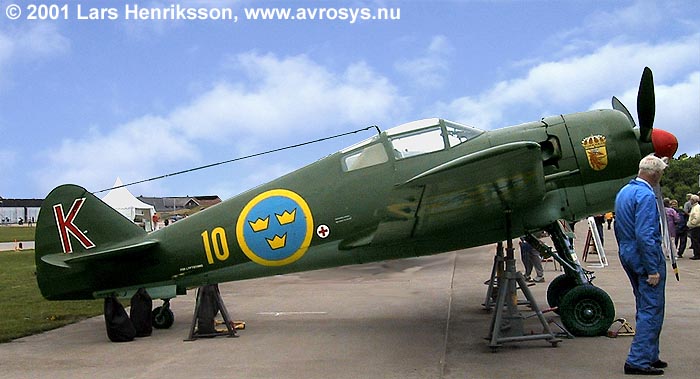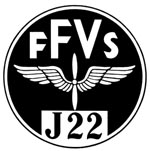| J 22 - FFVS J 22 (1943-1952) | ||
| Page 1 (2) | ||
|
|
||
 |
||
|
When the WWII broke out in 1939, the Swedish Air
Force had only one Wing equipped with fighters. It was F 8 at Barkarby,
intended for the defence of Stockholm. In February 1940, it was decided
to establish further two Fighter Wings, F 9 near Gothenburg and F 10 in
the south of Sweden. Two more Fighter Wings were established
during the WWII, F 13 at Norrköping and F 16 at Uppsala. New fighter
aircraft became of highest priority.
Obtaining
fighter aircraft from abroad was impossible due to the war situation.
SAAB, the Swedish Aeroplane Company, was in full production, but was
concentrated on the production of bombers and reconnaissance aircraft.
The lack of aluminium and other strategic materials was great, and SAAB
needed more than they could get. In this situation, the clever aircraft
engineer and designer Bo Lundberg got the task to design a fighter
aircraft. Only domestic materials would be used. The new design would
consist of a frame of steel tubing, strengthened by a skin of birch
plywood panels. The only engine available was the STW C-3 ”Swedish
Twin Wasp”. This was a Swedish copy, built without license, of the
Pratt & Whitney Twin Wasp of 1065 hp.
An advantage was that the Air Force’s central
workshops had a long experience of working with steel and wood.
Engineers and draughtsmen would be recruited from the Air Administration
and other sources outside SAAB. The Air Force workshops in Stockholm
(FFVS) was to assemble the aircraft, mostly from parts made by more than
500 sub-contractors all around Sweden.
T he work advanced rapidly, and in September
1942, the first J 22 took to the sky. Serial production began in the
summer of 1943.
The J 22 was built in two different versions, the J
22A armed with two 7,9 mm machine-guns and two 13,2 mm automatic
cannons, and J 22B armed with four automatic cannons. 120 J 22A and 78 J 22B were
produced.
Photo at top and at bottom: J 22A c/n 185, Sw AF/n 22185 in the markings of First (red) Squadron) of Wing F 10. It is owned by Flygvapenmuseum, but placed at F 10 Kamratförening. Photo above taken at F 7, Såtenäs, in June 2000. Photo at bottom from F 10 in June 1990. J 22 of Wing F 13 (Norrköping) from the days of active service.
J
22A: Length: 7,80 m. Span: 10,00 m.
Maximum take-off weight:
2,835 kg. Max. speed: 575 km/h. |
||
|
For the Model Builder |
|
|
|
|
||
|
Link to You Tube - "J22 -Swedish
WW 2 fighter starting engine". The
aircraft is J 22A, c/n 22185 shown at top of the page.
The mechanic turns the crank to the flywheel. When he has achived a
certain speed of the flywheel, the engine is connected to it. The ignition
is switched on and the engine starts. |
 |
|
|
|
||
|
|
||
|
|
||
|
© Lars Henriksson |
|
Updated 2010-03-17 |
|
|
||
